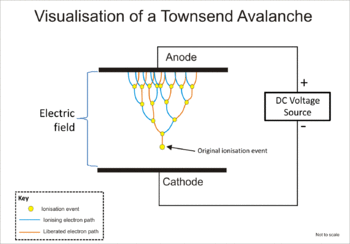
Back Descàrrega de Townsend Catalan Descarga de Townsend Spanish Townsendi lahendus Estonian تخلیه تاونزند Persian Décharge de Townsend French Townsend-lavina Hungarian Pelepasan Townsend ID Valanga Townsend Italian タウンゼント放電 Japanese 타운센드 방전 Korean

In electromagnetism, the Townsend discharge or Townsend avalanche is an ionisation process for gases where free electrons are accelerated by an electric field, collide with gas molecules, and consequently free additional electrons. Those electrons are in turn accelerated and free additional electrons. The result is an avalanche multiplication that permits significantly increased electrical conduction through the gas. The discharge requires a source of free electrons and a significant electric field; without both, the phenomenon does not occur.
The Townsend discharge is named after John Sealy Townsend, who discovered the fundamental ionisation mechanism by his work circa 1897 at the Cavendish Laboratory, Cambridge.